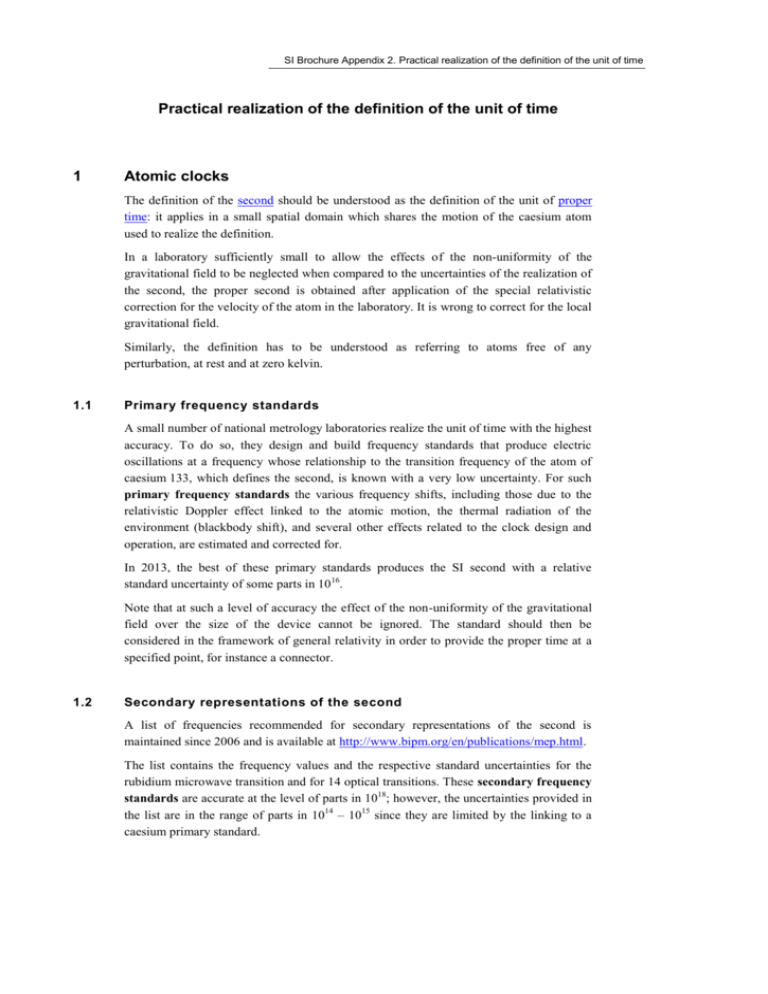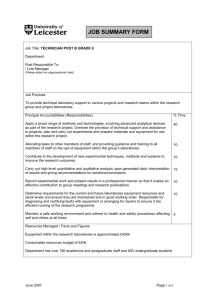Practical realization of the definition of the unit
advertisement

SI Brochure Appendix 2. Practical realization of the definition of the unit of time Practical realization of the definition of the unit of time 1 Atomic clocks The definition of the second should be understood as the definition of the unit of proper time: it applies in a small spatial domain which shares the motion of the caesium atom used to realize the definition. In a laboratory sufficiently small to allow the effects of the non-uniformity of the gravitational field to be neglected when compared to the uncertainties of the realization of the second, the proper second is obtained after application of the special relativistic correction for the velocity of the atom in the laboratory. It is wrong to correct for the local gravitational field. Similarly, the definition has to be understood as referring to atoms free of any perturbation, at rest and at zero kelvin. 1.1 Primary frequency standards A small number of national metrology laboratories realize the unit of time with the highest accuracy. To do so, they design and build frequency standards that produce electric oscillations at a frequency whose relationship to the transition frequency of the atom of caesium 133, which defines the second, is known with a very low uncertainty. For such primary frequency standards the various frequency shifts, including those due to the relativistic Doppler effect linked to the atomic motion, the thermal radiation of the environment (blackbody shift), and several other effects related to the clock design and operation, are estimated and corrected for. In 2013, the best of these primary standards produces the SI second with a relative standard uncertainty of some parts in 1016. Note that at such a level of accuracy the effect of the non-uniformity of the gravitational field over the size of the device cannot be ignored. The standard should then be considered in the framework of general relativity in order to provide the proper time at a specified point, for instance a connector. 1.2 Secondary representations of the second A list of frequencies recommended for secondary representations of the second is maintained since 2006 and is available at http://www.bipm.org/en/publications/mep.html. The list contains the frequency values and the respective standard uncertainties for the rubidium microwave transition and for 14 optical transitions. These secondary frequency standards are accurate at the level of parts in 1018; however, the uncertainties provided in the list are in the range of parts in 1014 – 1015 since they are limited by the linking to a caesium primary standard. SI Brochure Appendix 2. Practical realization of the definition of the unit of time 1.3 Other frequency standards Primary frequency standards can be used for calibration of the frequency of other frequency standards used as clocks in national time-service laboratories. These are generally commercial caesium clocks characterized by a very good long-term frequency stability: they are able to maintain a frequency with a stability better than 1 part in 10 14 over a few months, and thus constitute very good “time-keepers”. The relative uncertainty of their frequencies is of the order of 5 × 1013 in stand-alone operations. Time metrology laboratories also use hydrogen masers which rely on the 1.4 GHz hyperfine transition in atomic hydrogen. Masers have a much better short-term frequency stability than any commercial caesium clock. These instruments are thus used in all applications which require a stable reference over intervals of less than one day (frequency stability of about 1 part in 1015 for averaging times of a few hours). 2 Clock comparisons The synchronization of clocks operating in widely separated laboratories is an important concern for time metrology. It calls for accurate methods of clocks comparison that can be operated anywhere on the Earth, at any time. In the context of general relativity, the concept of synchronization is arbitrary, and lies on a convention for simultaneity and synchronization. The Global Navigation Satellite Systems (GNSS) provide a satisfactory solution to the problem of time transfer. The two systems orbiting − the US Global Positioning System (GPS) and the Russian Global Navigation Satellite System (GLONASS), composed respectively of 30 and 24 non-geostationary satellites − are designed for positioning, but have the particular feature that the satellites are equipped with atomic clocks which broadcast time signals. The signal received from one satellite in a laboratory allows the time difference between the local time scale and the GNSS system time to be determined with a Type A uncertainty of a few nanoseconds when averaging over 15 minutes. Modern receivers allow the simultaneous reception of signals from several satellites, and make use of signals transmitted on two frequencies. In the past, for data to be compared between two laboratories it was essential that they be collected under the strict condition of “common view”. Common-view analysis still has some advantages, but it is no longer required in the case of GPS time transfer thanks to the availability in deferred time of very precise satellite ephemerides and of ionospheric parameters. Alternatively, one can average over a set of observations in each laboratory and calculate the offsets between the local time scales from the differences in these mean values. The GPS is used on a regular basis to link national laboratories in many countries. The use of GLONASS satellites in common-views for official time comparisons made possible to establish a time link between two laboratories in October 2009 thanks to the completion of the satellite constellation, and increased to six links in 2013 with the operation in many laboratories of suitable dual-system GPS/GLONASS receivers. Two-way satellite time and frequency transfer (TWSFTF) is used regularly for comparing more than ten timing centres world-wide. It consists of the quasi-simultaneous transmission of radiofrequency signals between two laboratories, via a geostationary satellite. It provides sub-nanosecond accuracy in quasi real-time after typically 2 minutes of measurement. SI Brochure Appendix 2. Practical realization of the definition of the unit of time All these methods of time comparison are subject to relativistic effects typically of several tens of nanoseconds, so corrections must be applied to take them into account. 3 Time scales National laboratories usually operate a number of clocks. These are run independently of one another and their data are combined to generate a perennial time scale. This scale is more stable and more accurate than that of any individual contributing clocks. The scale is based on the results of local clock comparisons in the laboratory. These atomic time scales are generally designated TA(k) for laboratory k. Optimal combination of all the results of comparisons between the clocks maintained in the national time-service laboratories results in a world reference time scale, International Atomic Time (TAI), approved by the CGPM at its 14th meeting in 1971 (Resolution 1; CR, 77 and Metrologia, 1972, 8, 35). The first definition of TAI was that submitted by the Consultative Committee for the Definition of the Second (CCDS) 1 in 1970 to the CIPM (Recommendation S 2; PV, 38, 110 and Metrologia, 1971, 7, 43): International Atomic Time (TAI) is the time reference coordinate established by the Bureau International de l'Heure on the basis of the readings of atomic clocks operating in various establishments in accordance with the definition of the second, the unit of time of the International System of Units. In the framework of general relativity TAI must be regarded as a time coordinate (or coordinate time): its definition was therefore completed as follows (declaration of the CCDS, BIPM Com. Cons. Déf. Seconde, 1980, 9, S 15 and Metrologia, 1981, 17, 70): TAI is a coordinate time scale defined in a geocentric reference frame with the SI second as realized on the rotating geoid as the scale unit. This definition was amplified by the International Astronomical Union in 1991, Resolution A42, which states that TAI is a realized time scale whose ideal form, neglecting a constant offset of 32.184 s, is Terrestrial Time (TT), itself related to the time coordinate of the geocentric reference frame, Geocentric Coordinate Time (TCG), by a constant rate. Responsibility for TAI was accepted by the CIPM and transferred from the Bureau International de l’Heure to the BIPM on 1 January 1988. TAI is processed in two steps. 1 A weighted average based on some 420 clocks maintained under metrological conditions in about seventy laboratories is first calculated. The algorithm used is optimized for long-term stability, which requires observation of the behaviour of clocks over a long duration. In consequence, TAI is a deferred-time time scale, available with a delay of a few weeks. In 2013, the relative frequency stability of TAI was estimated to 3 parts in 1016 for mean durations of one month. The CCDS has been renamed Consultative Committee for Time and Frequency (CCTF) since 1997. 2 For details see the Proceedings of the 21st General Assembly of the IAU, Buenos Aires, IAU Transactions, 1991, vol. XXIB (Kluwer) SI Brochure Appendix 2. Practical realization of the definition of the unit of time The frequency accuracy of TAI is then evaluated by comparing the TAI scale unit with various realizations of the SI second produced by primary frequency standards. This requires the application of a correction to compensate for the relativistic frequency shift between the location of the primary standard and a fixed point on a conventional surface of equal gravity potential, very close to the rotating geoid. The magnitude of this correction is, between points fixed on the surface of the Earth, of the order of 1 part in 1016 per metre of altitude. During 2013, the fractional deviation between the TAI scale unit and the SI second on the rotating geoid was a few parts in 1016, and was known with a standard uncertainty of about 3 × 1016. Both numerical values change slightly from month to month and are reported in the BIPM Circular T. This difference is reduced whenever necessary by steering the frequency of TAI through the application of corrections, of magnitude a few parts in 10 16, every month. This method improves the accuracy of TAI while not degrading its middle-term stability. TAI is not distributed directly in everyday life. The time in common use (broadcast by radio, television, the speaking clock...) is referred to a time scale called Coordinated Universal Time (UTC) as recommended by the CGPM at its 15th meeting in 1975 in its Resolution 5 (CR, 104 and Metrologia, 1975, 11, 180). UTC differs from TAI by a whole number of seconds such that UTC – TAI = –35 s until at least 1 January 2014. This difference can be modified in steps of 1 s, using a positive or negative leap second, in order to keep UTC in agreement with the time defined by the rotation of the Earth such that, when averaged over a year, the Sun crosses the Greenwich meridian at noon UTC to within 0.9 s. In addition, the legal time of most countries is offset from UTC by a whole number of hours to establish time zones and summer time. National time-service laboratories, which contribute to the formation of TAI at the BIPM, maintain an approximation of UTC, known as UTC(k) for laboratory k, which in some cases represents the basis of the legal time in those countries. UTC is disseminated monthly through the publication of the offsets [UTC – UTC(k)] at five-day intervals. These offsets amount to only a few tens of nanoseconds for about twenty of the seventy laboratories involved. Since January 2005, the uncertainties on these offsets have also been given in the BIPM Circular T. The computation of UTC is the basis of key comparison CCTF-K001.UTC, defined in the framework of the CIPM Mutual Recognition Arrangement (CIPM MRA): the offsets [UTC – UTC(k)] and their uncertainties constitute the degrees of equivalence of the laboratories participating to the key comparison. Last updated: 1 June 2013







